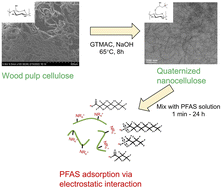Efficient removal of short-chain and long-chain PFAS by cationic nanocellulose†
Abstract
Although most manufacturers stopped using long-chain per- and polyfluoroalkyl substances (PFASs), including perfluorooctanoic acid (PFOA) and perfluorooctanesulfonic acid (PFOS), short-chain PFASs are still widely employed. Short-chain PFASs are less known in terms of toxicity and have different adsorption behavior from long-chain PFASs. Previous studies have shown electrostatic interaction with the adsorbent to be the dominant mechanism for the removal of short-chain PFASs. In this study, we designed a high charge density cationic quaternized nanocellulose (QNC) to enhance the removal of both short- and long-chain PFASs from contaminated water. Systematic batch adsorption tests were conducted using the QNC adsorbent to compare its efficiency against PFASs with varying chain lengths and functional groups. From the kinetic study, PFBA (perfluorobutanoic acid), PFBS (perfluorobutanesulfonic acid) and PFOS showed rapid adsorption rates, which reached near equilibrium values (>95% of removal) between 1 min to 15 min, while PFOA required a relatively longer equilibration time of 2 h (it obtained 90% of removal within 15 min). According to the isotherm results, the maximum adsorption capacity (Qm) of the QNC adsorbent exhibited the following trend: PFOS (Qm = 559 mg g−1 or 1.12 mmol g−1) > PFOA (Qm = 405 mg g−1 or 0.98 mmol g−1) > PFBS (Qm = 319 mg g−1 or 1.06 mmol g−1) > PFBA (Qm = 121 mg g−1 or 0.57 mmol g−1). This adsorption order generally matches the hydrophobicity trend among four PFASs associated with both PFAS chain length and functional group. In competitive studies, pre-adsorbed short-chain PFASs were quickly desorbed by long-chain PFASs, suggesting that the hydrophobicity of the molecule played an important role in the adsorption process on to QNC. Finally, the developed QNC adsorbent was tested to treat PFAS-contaminated groundwater, which showed excellent removal efficiency (>95%) for long-chain PFASs (C7–C9) even at a low adsorbent dose of 32 mg L−1. However, short-chain PFASs (i.e., PFBA and perfluoropentanoic acid (PFPeA)) were poorly removed by the QNC adsorbent (0% and 10% removal, respectively) due to competing constituents in the groundwater matrix. This was further confirmed by controlled experiments that revealed a drop in the performance of QNC to remove short-chain PFASs at elevated ionic strength (NaCl), but not for long-chain PFASs, likely due to charge neutralization of the anionic functional group of PFASs by inorganic cations. Overall, the QNC adsorbent featured improved PFAS adsorption capacity at almost two-fold of PFAS removal by granular activated carbons, especially for short-chain PFASs. We believe, QNC can complement the use of common treatment methods such as activated carbon or ionic exchange resin to remove a wide range of PFAS pollutants, heading towards the complete remediation of PFAS contamination.

- This article is part of the themed collection: PFAS: cleaning up drinking water


 Please wait while we load your content...
Please wait while we load your content...